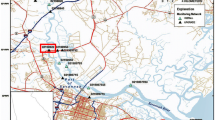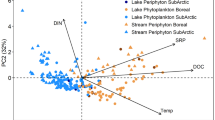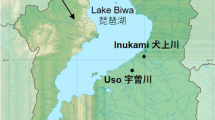Abstract
Microalgae may contribute more to salt marsh productivity than realized, underscoring the importance of understanding algal dynamics in such systems. Benthic and planktonic chlorophyll-a (surrogate for total algal biomass), sediment ash-free dry weight, total suspended solids, salinity, and nutrients were examined in intermittently connected marsh ponds in the subtropical Guadalupe Estuary, Texas, USA to determine the effects of hydrologic connections on algal biomass in this system. From May 2005 to May 2006, several high water events resulting in surface water connections between ponds and nearby tidal creeks occurred, followed by disconnection and, at times, pond desiccation. During periods of disconnection, algal biomass was higher in both the benthos and the water column than during connection events when flushing occurred. Since connection events did not increase NOx, the primary source of dissolved inorganic nitrogen seemed to be nutrient cycling within the ponds. Data at the aggregated level, i.e., chlorophyll-a, indicated this system followed the flood pulse concept. During high water events, algal biomass may be exported to supplement the tidal creek food web (aquatic), whereas during low water events accumulated biomass within the ponds feed the marsh food web (terrestrial), which includes blue crabs (Callinectes sapidus) and the whooping crane (Grus americana).
Similar content being viewed by others
Literature Cited
Ahearn, D. S., J. H. Viers, J. F. Mount, and R. A. Dahlgren. 2006. Priming the productivity pump: flood pulse driven trends in suspended algal biomass distribution across a restored floodplain. Freshwater Biology 51: 1417–33.
Akin, S. and K. O. Winemiller. 2006. Seasonal variation in food web composition and structure in a temperate tidal estuary. Estuaries and Coasts 29: 552–67.
American Public Health Association (APHA). 1989. Standard Methods for the Examination of Water and Wastewater. seventeenth edition. APHA, Washington, DC, USA.
Amoros, C. and G. Bornette. 2002. Connectivity and biocomplexity in waterbodies of riverine floodplains. Freshwater Biology 47: 761–76.
Bornette, G., C. Amoros, and N. Lamoroux. 1998. Aquatic plant diversity in riverine wetlands: the role of connectivity. Freshwater Biology 39: 267–83.
Butzler, R. and S. E. Davis. 2006. Growth patterns of Carolina Wolfberry (Lycium carolinianum) in the salt marshes of Aransas National Wildlife Refuge, TX. Wetlands 26: 845–53.
Buyukates, Y. and D. L. Roelke. 2005. Investigating system characteristics of a Southeast Texas wetland: Nutrient and plankton dynamics of a tidal creek in lower Nueces Delta. Journal of Applied Sciences 5: 820–28.
Chavez-Ramirez, F. 1996. Food availability, foraging ecology, and energetics of whooping cranes wintering in Texas. Ph.D. Dissertation. Texas A&M University, College Station, TX, USA.
Cloern, J. E. 2007. Habitat connectivity and ecosystem productivity: implications from a simple model. The American Naturalist 169: E21-E33.
Currin, C. A., S. Y. Newell, and H. W. Paerl. 1995. The role of standing dead Spartina alternifora and benthic microalgae in salt marsh food webs: considerations based on multiple stable isotope analysis. Marine Ecology Progress Series 121: 99–116.
Darnell, T. M. and E. H. Smith. 2004. Avian use of natural and created salt marsh in Texas, USA. Waterbirds 27: 355–61.
Day, J. W., C. A. S. Hall, W. M. Kemp, and A. Yanez-Arancibia. 1989. Estuarine Ecology. John Wiley & Sons, New York, NY, USA.
Dean, W. E. 1974. Determination of carbonate and organic-matter in calcareous sediments and sedimentary-rocks by loss on ignition — comparison with other methods. Journal of Sedimentary Petrology 44: 242–48.
Fejes, E., D. Roelke, G. Gable, J. Heilman, K. McInnes, and D. Zuberer. 2005. Microalgal productivity, community composition, and pelagic food web dynamics in a subtropical, turbid salt marsh isolated from freshwater inflow. Estuaries 28: 96–107.
Gauch, H. G., Jr. 1982. Multivariate Analysis in Community Structure. Cambridge University Press, Cambridge, UK.
Grasshoff, K. and F. Koroleff. 1999. Determination of nutrients. p. 125–187. In K. Grasshoff, M. Ehrhardt, and K. Kremling (eds.) Methods of Seawater Analysis. Wiley-VC, New York, NY, USA.
Hein, T., C. Baranyi, W. Reckendorfer, and F. Schiemer. 2004. The impact of surface water exchange on the nutrient and particle dynamics in side-arms along the River Danube, Austria. Science of the Total Environment 328: 207–18.
Heino, J., P. Louhi, and T. Muotka. 2004. Identifying the scales of variability in stream macroinvertebrate abundance, functional composition and assemblage structure. Freshwater Biology 49: 1230–39.
Heiri, O., A. F. Lotter, and G. Lemcke. 2001. Loss on ignition as a method for estimating organic and carbonate content in sediments: reproducibility and comparability of results. Journal of Paleolimnology 25: 101–10.
Hoeinghaus, D. and S. E. Davis. 2007. Size-based trophic shifts of salt-marsh dwelling blue crabs elucidated by dual stable C and N isotope analyses. Marine Ecology Progress Series 334: 199–204.
Holland, A. F., R. G. Zingmark, and J. M. Dean. 1974. Quantitative evidence concerning stabilization of sediments by marine benthic diatoms. Marine Biology 27: 191–96.
Hopner, T. and K. Wonneberger. 1985. Examination of the connection between the patchiness of benthic nutrient efflux and epiphytobenthos patchiness on intertidal flats. Netherlands Journal of Sea Research 19: 277–85.
Hunt, H. E. and R. D. Slack. 1989. Winter diets of whooping and sandhill cranes in South Texas. Journal of Wildlife Management 53: 1150–54.
Jeffrey, S. W. and G. F. Humphrey. 1975. New spectrophotometric equations for determining chlorophylls a, b, c1 and c2 in higher-plants, algae and natural phytoplankton. Biochemie Und Physiologie Der Pflanzen 167: 191–94.
Jongman, R. H., G. C. J. F. TerBraak, and O. F. R. Van Tongren (eds.). 1995. Data Analysis in Community and Landscape Ecology. Cambridge University Press, Cambridge, UK.
Junk, W. J., P. B. Bayley, and R. E. Sparks. 1989. The flood pulse concept in river-floodplain systems. p. 110–127. In D. P. Dodge (ed.) Proceedings of the International Large River Symposium. Canadian Special Publication of Fisheries and Aquatic Sciences 106.
Kneib, R. T., A. E. Stiven, and E. B. Haines. 1980. Stable carbon isotope ratios in Fundulus heteroclitus (L) muscle-tissue and gut contents from a North Carolina Spartina marsh. Journal of Experimental Marine Biology and Ecology 46: 89–98.
Kwak, T. J. and J. B. Zedler. 1997. Food web analysis of southern California coastal wetlands using multiple stable isotopes. Oecologica 110: 262–77.
LaFever, K. E. 2006. Spatial and temporal winter territory use and behavioral responses of whooping cranes to human activities. M.S. Thesis. Texas A&M University, College Station, TX, USA.
Leibowitz, S. G. and K. C. Vining. 2003. Temporal connectivity in a prairie pothole complex. Wetlands 23: 13–25.
McCune, B., J. B. Grace, and D. L. Urban. 2002. Analysis of Ecological Communities. MjM Software Design, Gleneden Beach, OR, USA.
Melville, A. J. and R. M. Connolly. 2003. Spatial analysis of stable isotope data to determine primary sources of nutrition for fish. Oecologia 136: 499–507.
Middleton, B. (ed.). 2002. Flood Pulsing in Wetlands: Restoring the Natural Hydrological Balance. John Wiley & Sons, Inc, New York, NY, USA.
Moens, T., C. Luyten, J. J. Middleburg, P. M. J. Herman, and M. Vincx. 2002. Tracing organic matter sources of estuarine tidal flat nematodes with stable carbon isotopes. Marine Ecology-Progress Series 234: 127–37.
Montoya, J. V., D. L. Roelke, K. O. Winemiller, J. Cotner, and J. Snider. 2006. Hydrological seasonality and benthic algal biomass in a Neotropical floodplain river. Journal of the North American Benthological Society 25: 157–170.
Odum, W. E., E. P. Odum, and H. T. Odum. 1995. Nature’s pulsing paradigm. Estuaries 18: 547–555.
Page, H. M. 1997. Importance of vascular plant and algal production to macro-invertebrate consumers in a southern California salt marsh. Estuarine Coastal and Shelf Science 45: 823–34.
Pai, S. C., C. C. Yang, and J. P. Riley. 1990. Effects of acidity and molybdate concentration on the kinetics of the formation of the phosphoantimonylmolybdenum blue complex. Analytica Chimica Acta 229: 115–20.
Peterson, B. J. and R. W. Howarth. 1987. Sulfur, carbon, and nitrogen isotopes used to trace organic-matter flow in the saltmarsh estuaries of Sapelo Island, Georgia. Limnology and Oceanography 32: 1195–1213.
Polis, G. A., R. D. Holt, B. A. Menge, and K. O. Winemiller. 1996. Temporal and spatial components of food webs. p. 435–60. In G. A. Polis and K. O. Winemiller (eds.) Food Webs: Integration of Patterns and Dynamics. Chapman and Hall, New York, NY, USA.
Pringle, C. M. 2001. Hydrologic connectivity and the management of biological reserves: a global perspective. Ecological Applications 11: 981–98.
Rizzo, W. 1990. Nutrient exchanges between the water column and a subtidal benthic microalgal community. Estuaries 13: 219–26.
Roelke, D. L., L. A. Cifuentes, and P. M. Eldridge. 1997. Nutrient and phytoplankton dynamics in a sewage impacted gulf coast estuary: a field test of the PEG-model and Equilibrium Resource Competition theory. Estuaries 20: 725–42.
Roelke, D. L., J. Cotner, J. V. Montoya, C. Del Castillo, S. Davis, J. Snider, G. Gable, and K. O. Winemiller. 2006. Optically determined sources of allochthonous organic matter and metabolic characterizations in a tropical oligotrophic river and associated lagoon. Journal of the North American Benthological Society 25: 185–97.
Schemel, L. E., T. R. Sommer, A. B. Müller-Solger, and W. C. Harrell. 2004. Hydrologic variability, water chemistry, and phytoplankton biomass in a large floodplain of the Sacramento River, CA, USA. Hydrobiologia 513: 129–39.
Sommer, U., Z. M. Gliwicz, W. Lampert, and A. Duncan. 1986. The PEG-model of seasonal succession of planktonic events in fresh waters. Archiv für Hydrobiologie 106: 433–471.
Sullivan, M. J. and C. A. Moncreiff. 1990. Edaphic algae are an important component of salt-marsh food-webs — evidence from multiple stable isotope analyses. Marine Ecology Progress Series 62: 149–59.
Tockner, K., D. Pennetzdorfer, N. Reiner, F. Schiemer, and J. V. Ward. 1999. Hydrological connectivity, and the exchange of organic matter and nutrients in a dynamic riverfloodplain system (Danube, Austria). Freshwater Biology 41: 521–35.
Ward, J. V. 1989. The four-dimensional nature of lotic ecosystems. Journal of the North American Benthological Society 8: 2–8.
Ward, J. V., K. Tockner, and F. Schiemer. 1999. Biodiversity of floodplain river ecosystems: ecotones and connectivity. Regulated Rivers-Research & Management 15: 125–39.
Weinstein, M. P., S. Y. Litvin, and V. G. Guida. 2005. Considerations of habitat linkages, estuarine landscapes and the trophic spectrum in wetland restoration design. Journal of Coastal Research 40: 51–63.
Winemiller, K. O. 1990. Spatial and temporal variation in tropical fish trophic networks. Ecological Monographs 60: 331–67.
Author information
Authors and Affiliations
Corresponding author
Rights and permissions
About this article
Cite this article
Miller, C.J., Davis, S.E., Roelke, D.L. et al. Factors influencing algal biomass in intermittently connected, subtropical coastal ponds. Wetlands 29, 759–771 (2009). https://doi.org/10.1672/08-69.1
Received:
Accepted:
Issue Date:
DOI: https://doi.org/10.1672/08-69.1




